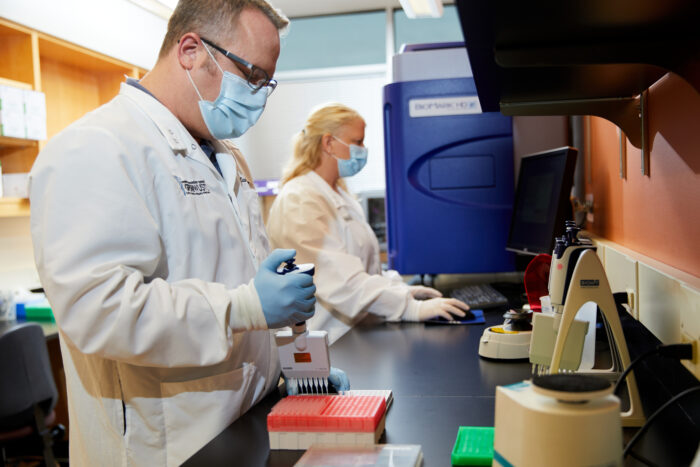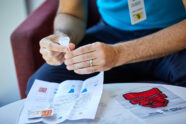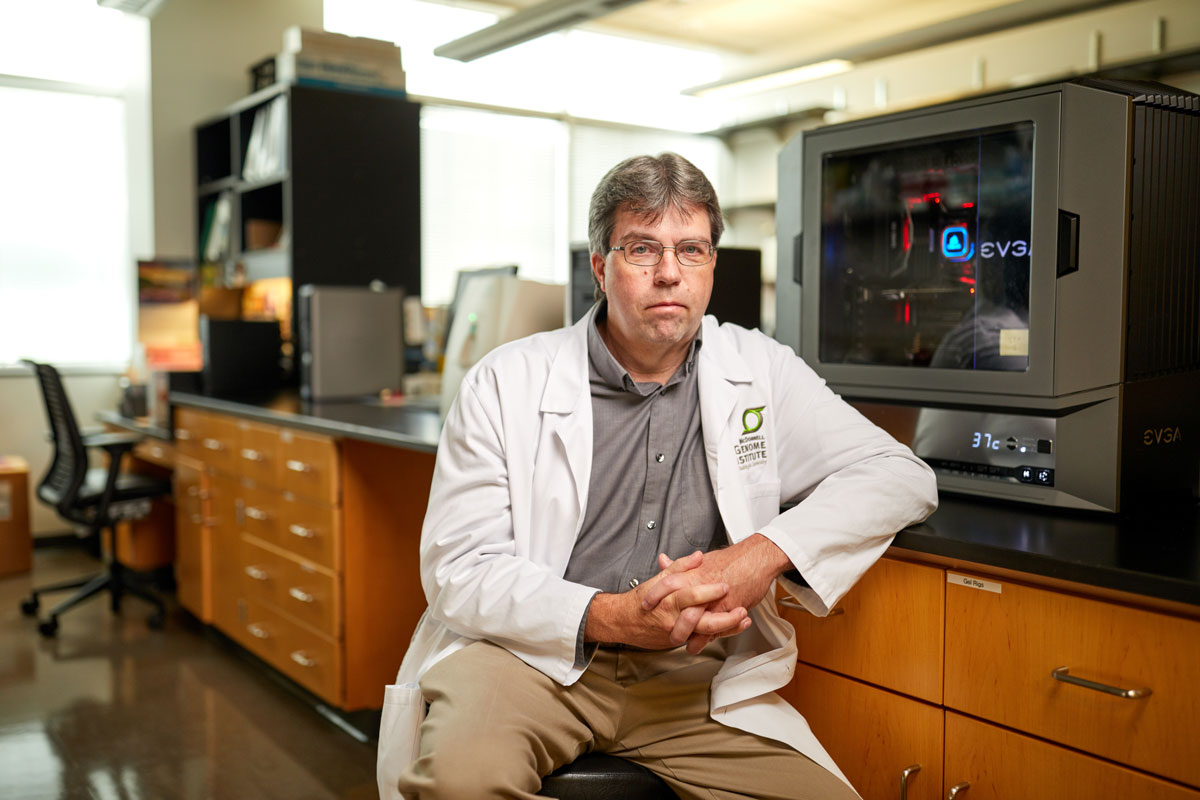Washington University develops COVID-19 saliva test
Test is faster, simpler than nasal, oral swab tests and enables screening on a massive scale
 Matt Miller
Matt MillerWashington University School of Medicine in St. Louis has developed a saliva-based test for COVID-19 that is faster and easier than the swab tests currently in use. Chris Sawyer, lab manager, and Lauren Burcea, clinical lab manager, work with test materials at the university's Genome Technology Access Center.
A new saliva test to detect the SARS-CoV-2 virus has been developed by researchers at Washington University School of Medicine in St. Louis. Results from the COVID-19 diagnostic test are available in a few hours and, ideally, able to be communicated to people tested within a day. Highly sensitive to detecting even tiny levels of the virus in a saliva sample, the test does not require special swabs and reagents that have been in short supply.
Developed in collaboration with the biotechnology company Fluidigm, the test could help simplify and expand the availability of COVID-19 diagnostic testing across broad populations. Such testing does not rely on the extraction of viral RNA to detect the virus – a time-consuming and expensive process – and could be scaled up easily, in part because people can collect their own saliva samples, relieving health-care workers of the need to conduct sample collection as they do for nasal and throat swab tests.
On Aug. 25, Fluidigm received emergency use authorization (EUA) from the Food and Drug Administration as the manufacturer of the test. This authorization allows the university to perform the test. Washington University filed a separate EUA application with the FDA that is still pending.
The saliva test was developed by a large, highly skilled team from the Department of Genetics and the McDonnell Genome Institute, both at Washington University School of Medicine.
“This is a significant advance in COVID-19 testing that is a simpler, faster and more economical test that can greatly expand our ability to detect the level of COVID-19 infection within the community via large-scale population screening for the SARS-CoV-2 virus,” said Jeffrey Milbrandt, MD, PhD, the James S. McDonnell Professor and head of the Department of Genetics and the McDonnell Genome Institute.
 Related: Podcast: The making of a fast, accurate saliva test for COVID-19
Related: Podcast: The making of a fast, accurate saliva test for COVID-19
This episode of 'Show Me the Science' focuses on a saliva test developed by School of Medicine scientists to detect the virus that causes COVID-19
According to the researchers, the test will allow for rapid testing of large numbers of people, which is essential for a safe return to work or school as economies strive to open up. Supporting its mission of education and research, Washington University’s faculty, staff and students could return to campus and potentially be screened to monitor levels of the virus in the community and stop it from spreading. The ability to scale up the number of tests that can be conducted also has the potential to help St. Louis city and county as well as the state of Missouri and regional businesses reopen safely. The saliva tests also could be given periodically to residents of nursing home and retirement communities, who are more vulnerable to infection because of age. Those who test positive could be quickly identified and quarantined.
“People can collect the sample themselves, and it doesn’t require an uncomfortable nasal swab,” Milbrandt said. “Another problem with current testing is the shortage of certain lab supplies that are required to process viral samples. We have developed a method to process the saliva samples that doesn’t require these specialized supplies.”
 Matt Miller
Matt MillerThe new test allows individuals to provide a saliva sample by spitting into a small test tube, eliminating the need for health-care workers to insert long nasal swabs deep into the nasal cavity. The researchers conducted experiments to show that the viral particles in the saliva sample remain stable for testing purposes for extended periods of time.
The test will be conducted at the McDonnell Genome Institute in the Genome Technology Access Center on the Washington University Medical Campus. The McDonnell Genome Institute is certified to conduct diagnostic testing on human samples under national regulatory standards known as Clinical Laboratory Improvement Amendments (CLIA).
“This test reflects an incredible effort over the last six months by a team at the McDonnell Genome Institute, assembled to tackle the next era of health challenges using functional genomics strategies and the precision medicine paradigm,” said David H. Perlmutter, MD, executive vice chancellor for medical affairs and the George and Carol Bauer Dean of the School of Medicine. “This group’s work was based on the assumption that testing capacity would need to address the population here in St. Louis and beyond, including the university, other schools, businesses and local communities, and that enormous skill and perseverance were necessary to accomplish this goal.”
The new test helps eliminate supply chain difficulties that have plagued COVID-19 testing across much of the country. In a major improvement over other tests, this new test involves processing the saliva in a way that allows the RNA fingerprint of the virus to be detected directly in the specimen without the RNA extraction kits that are often in short supply. This element of the new process, in combination with state-of-the art microfluidics technology from Fluidigm, results in a faster, less expensive test. The researchers estimate that the McDonnell Genome Institute potentially could perform tens of thousands of saliva tests per week for the SARS-CoV-2 virus, if needed.
“There’s an urgent need to simplify testing for COVID-19 so that people who are infected can be easily and quickly identified,” said Richard Head, a professor of genetics and director of the Genome Technology Access Center at the McDonnell Genome Institute. “The test we developed doesn’t require RNA extraction, a time-consuming and expensive step necessary for other COVID-19 tests. Our team found the right recipe, so to speak, to allow direct testing for the virus in saliva samples, and it works exceptionally well. The minimum number of viral particles that we can detect is extremely small — about six viruses per microliter. We’re well below the levels of virus that people produce when they have symptoms. We’re hopeful we’ll be able to detect positive cases even before people start having symptoms and in those who remain asymptomatic.”
The researchers verified the saliva test against the standard nasal swab tests and found that the new test’s results aligned with the standard test results — whether positive or negative — in all cases. The researchers also ran the new test on hundreds of known negative saliva samples, and no false positives were detected. Each test also is conducted in quadruplicate to help ensure accuracy. It’s harder to test for false negatives because large numbers of known positive samples are more difficult to obtain. The researchers said they will need to conduct more tests to have a better idea of the false positive and false negative rates of this saliva test on a large scale, but the evidence so far suggests the test is extremely sensitive and specific for detecting SARS-CoV-2, the virus that causes COVID-19.
The researchers also anticipate being able to use the Fluidigm technology to test saliva samples for multiple viruses simultaneously.
“In theory, we could test for COVID-19 and also scan for influenza and other viruses, for example, in the same saliva samples, with no loss in the speed of the processing and little impact on cost,” Milbrandt said. “At the moment, understandably, people get nervous about coronavirus if they develop even mild symptoms of a cold. As we get into cold and flu season in the fall, being able to distinguish between different viral infections is where this technology could be very beneficial.”
Added Head: “We want this to be a COVID-19 test process that can be used on a massive scale across the country and around the world. The test is fast and relatively inexpensive. If many certified labs can begin using this same testing process, large numbers of people could be screened relatively easily. This will be valuable for helping identify new cases, an important step in preventing further spread of this virus.”
 Matt Miller
Matt MillerIn deep appreciation to the following people who played a major role in making the Washington University COVID-19 saliva test happen. This was a massive team effort with many members of the faculty and staff from multiple departments and institutes working together under very challenging timelines. We are deeply grateful.
Sincerely,
David H. Perlmutter, MD
Executive Vice Chancellor for Medical Affairs and Dean of the School of Medicine
Andrew D. Martin, PhD
Chancellor
McDonnell Genome Institute:
Richard Head
Lauren Burcea
Shelly O’Laughlin
Chris Sawyer
Robert Fulton
Catrina Fronick
Michael Heinz
Lisa Cook
Department of Genetics:
Jeffrey Milbrandt, MD, PhD
Robi Mitra, PhD
William Buchser, PhD
Lucinda Fulton
Matthew Lalli, PhD
Josh Langmade
Department of Medicine:
Bill Powderly, MD
Jane O’Halloran MD, PhD
Clay Dunagan, MD
Charles Goss PhD
Michael Klebert PhD
Lisa Kessels
AJ Winingham
Department of Emergency Medicine:
Stacey House MD, PhD
Phil Mudd MD, PhD
Aaron Day
Institute for Informatics:
Philip Payne, PhD
Ian Lackey
Ricardo Rodriguez
Albert Lai, PhD
Rachel Komeshak
Washington University Faculty Practice Plan:
Paul Scheel, MD
Eva Aagaard, MD
Christian Oncken
John Co
Amanda Wilkins
Rosi Fowler
Phil Lord
Student/Employee Health:
Jennifer Reneau
Cara Rotter
Cassie Schlemmer
Karen Winters, MD
Pathology and Immunology:
Richard Cote, MD
Julie Neidich, MD
Charles Eby, MD
Victor Brodsky, MD
Jonathan Heusel, MD, PhD
Carey-Ann Burnham, PhD
Neil Anderson, MD
Bijal Parikh, MD, PhD
Yang Cao, PhD
Michael Isaacs
Jared Amann-Stewart






